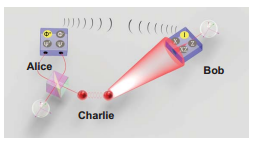Best of 2012: Chinese Physicists Smash Distance Record For Teleportation
“Teleportation is the extraordinary ability to transfer objects from one location to another without travelling through the intervening space.

The idea is not that the physical object is teleported but the information that describes it. This can then be applied to a similar object in a new location which effectively takes on the new identity.
And it is by no means science fiction. Physicists have been teleporting photons since 1997 and the technique is now standard in optics laboratories all over the world.
The phenomenon that makes this possible is known as quantum entanglement, the deep and mysterious link that occurs when two quantum objects share the same existence and yet are separated in space.
Teleportation turns out to be extremely useful. Because teleported information does not travel through the intervening space, it cannot be secretly accessed by an eavesdropper.
For that reason, teleportation is the enabling technology behind quantum cryptography, a way of sending information with close-to-perfect secrecy.
Unfortunately, entangled photons are fragile objects. They cannot travel further than a kilometre or so down optical fibres because the photons end up interacting with the glass breaking the entanglement. That severely limits quantum cryptography’s usefulness.
However, physicists have had more success teleporting photons through the atmosphere. In 2010, a Chinese team announced that it had teleported single photons over a distance of 16 kilometres. Handy but not exactly Earth-shattering.
Now the same team says it has smashed this record. Juan Yin at the University of Science and Technology of China in Shanghai, and a bunch of mates say they have teleported entangled photons over a distance of 97 kilometres across a lake in China.
Keep Reading
Most Popular
Large language models can do jaw-dropping things. But nobody knows exactly why.
And that's a problem. Figuring it out is one of the biggest scientific puzzles of our time and a crucial step towards controlling more powerful future models.
The problem with plug-in hybrids? Their drivers.
Plug-in hybrids are often sold as a transition to EVs, but new data from Europe shows we’re still underestimating the emissions they produce.
Google DeepMind’s new generative model makes Super Mario–like games from scratch
Genie learns how to control games by watching hours and hours of video. It could help train next-gen robots too.
How scientists traced a mysterious covid case back to six toilets
When wastewater surveillance turns into a hunt for a single infected individual, the ethics get tricky.
Stay connected
Get the latest updates from
MIT Technology Review
Discover special offers, top stories, upcoming events, and more.